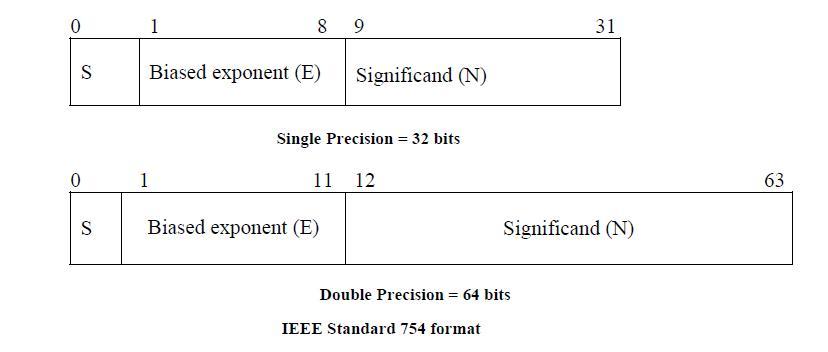컴퓨터 구조 floating point
Floating Point
real numbers( float in C)
1.0 * 2^-1 = 10.0 * 2^-2 = 0.1 * 2^0
binary point is not fixed (floating)
normalized number : 1.xxx * 2^yyy
Float point representation
(-1)^S * (1 + fraction) * 2^(exponent - bias)

-
single precision
bias = 127-0.75----dec = -11 * 2^(-2)----binary -1.1 * 2^(-1) S : 1, fraction : 10000...0(23bits), exponent : -1 + 127 = 0111 1110 1 | 0111 1110 | 1000...00 (23bits)| -
double precision
bias = 1024-0.75 S : 1, fraction : 1000...000 (52bits), exponent : 011 1111 1110
1|1000 0001|0100...0| ---- single precision
-1.01 * 2^2
Floating point Addition
0.5 + (-0.4375)?---(decimal)
0.5 = 1.000 * 2^-1
-0.4375(10) = -7/16 (2)= -111 * 2^-4 = -1.110 * 2^-2
-
compare the exponents and shifts the smaller number to the right
-1.110 * 2^-2 = -0.11 * 2^-1 - Add
(1.000 + (-0.111)) * 2 ^ -1 = 0.001 * 2 ^ -1 = 1.000 * 2^-4 -
Check for overflow or underflow -4는 -126~127사이이기 때문에 exponent 표현이 가능합니다. no oveflow, underflow
- Check 4 bit precision
1.000 * 2 ^ -4
exponent of the product : adding the components
(1.000 * 2 ^ -1) * (-1.110 * 2 ^ -2)
-
add exponents
-1 + (-2) = -3 -
product
1.000 * 1.110 = 1.110000 -
Check for overflow or underflow
-3은 -126 ~ 127사이 입니다. -
Check sign, 4bit precision
1.110 * 2 ^ -3
exercise
-
-1.25 single, double
-1.25 = -5/4 = -101/2^2 = -1.01 * 2^0 single ------- S : 1 exponent : 0111 1111 fraction : 01000...000(23bits) double ------- S : 1 exponent : 130 - 127 = 3 fraction : 010100...0(52bits) -
110000010010100…0 -> what number?(single) -1.0101 * 2^3
sign : 1 exponent : 130-127 = 3 fraction : 010100...0(23bits) -
0.375 + 1.5 = ?
0.75 = 3 / 2^3 = 1.1 * 2^-2 1.5 = 3 / 2 = 1.1 * 2^0 1. 1.1 * 2^-2 -> 0.011 * 2^0 2. 1.1 * 2^0 + 0.011 * 2^0 = 1.111 * 2^0 3. -126 <= 0(exponent) <= 127 4. 1.111 * 2^0 -
1.010(2) * 0101(2) = ?
(1.010 * 2^0) * (1.01 * 2^2) 1. add exponent (2 + 0) 2. 1.010 * 1.01 = 1.100100 3. -126<=2(exponent)<=127 4. check sign and 4 bits precision 1.100 * 2^2